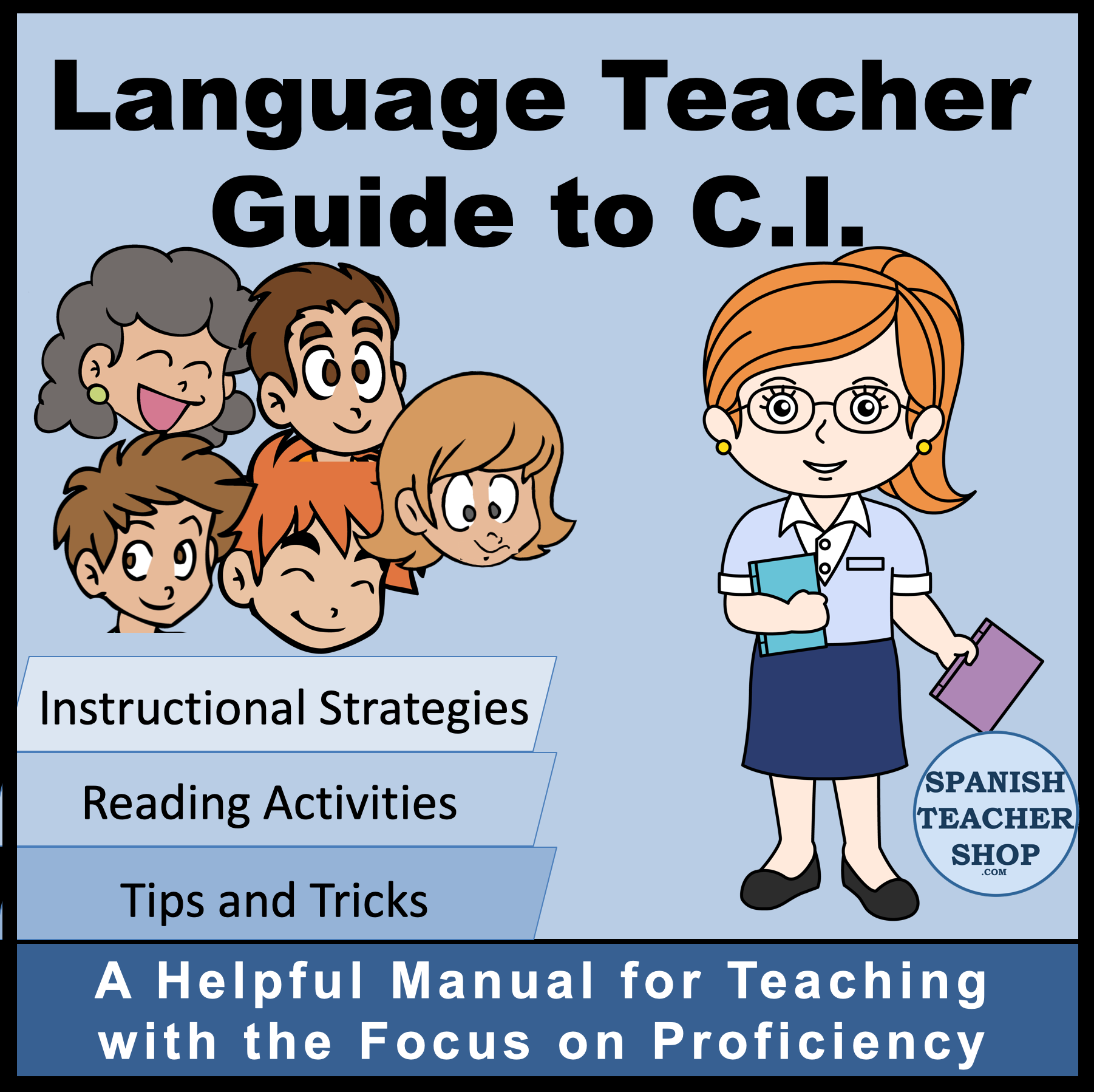Every teacher wants to be the best they can be for their students. While there are many attributes that can make a great teacher, most importantly, giving students comprehensible input, we can also observe some behaviors and routines that are in a great world language teacher’s classroom.
It’s good to be reminded of the actions that make a good foreign language teacher. A supervisor may use a checklist like these during an observation, you may want to self-assess your own classroom, or if you are really daring, have a student(s) check off on these.
Below you will find some rubrics we have found around the web, but first we’d like to highlight some we believe to be most essential.

- Units have real world language performance goals and students have opportunities to communicate in real world context.
- Teacher uses the target language to conduct class. The teacher uses a variety of methods to make language comprehensible.
- Students have adequate opportunities to process the language before being expected to produce language.
- Instructional activities keep all students engaged and on-task in using the language.
- Authentic materials are integrated into the lesson and exhibit cultural significance/perspective.
- The teacher measures student language proficiency in a variety of ways that focus on what the student can do with the language.
Take a look at the following rubrics. Print them out and check to see how often YOU do these things in your classes:
1. Full class observation Secondary (source unknown*)
2. WL Walkthrough (source unknown*)
3. Observation Checklist (posted by KSWLA, adapted from Starting
With
the
End
in
Mind,
2008,
Pearson
School)
4. What should I look for in an effective world language classroom (from KY Department of Education)
Check out the TELL (Teacher Effectiveness for Language Learning) Project, who has some great rubrics and self-assessments, including this checklist for teachers:

We’d like to hear your thoughts. What do you feel are the most important things going on in a world language classroom? What qualities does an excellent foreign language teacher possess? Share in the comments below.











Like the list!
I’ve always been a fan of peer-observations. I like seeing what other people are doing so I can incorporate other people’s activities and methods (or at least modify and reflect upon my own), and the observation checklists you posted seem like they’d be really helpful. Can’t wait to try them out!
Great list, but for one important issue.
If you have actual research evidence showing that the principled use of English in a WL classroom is harmful to acquisition, please let me know. I am not aware of any. I’m talking about a classroom with 90% or more TL, but where English is used to establish meaning. I really dislike the widespread myth that “good” teachers don’t use English. A shared native language is the single most effective means of establishing meaning available in the average classroom in the US. Obviously English should not be spoken at random, but using it with skill and forethought raises the effectiveness of class time.
I agree!
I agree. I am a 23 year teacher of Spanish. Through my experience, using English to explain problematic grammar issues to my fellow native English speakers have allowed them to become more successful in foreign language rather than leaving them with more questions trying to do double translations with native Spanish speakers. Just from my experience…..in my opinion!
Agree, I am not arguing for absolutely no English, but rather for *more* use of the language. The most important thing is for the language to be comprehensible. If the students can’t understand what’s going on, the language is worthless to them.
I do totally agree.
I agree! I have students who do not know the difference between a verb and a noun. I am doing them a disservice if I don’t break things down where they can comprehend what I am teaching.
thank you for this. I agree. My students struggle with English grammar. I can model a lot but I don’t have that many minutes with them and sometimes it makes it easier to explain to them what a noun and a verb are and to identify the pronouns. I did this with my 2nd quarter group, and they understood it well. I didn’t translate at all for my 1st quarter group and they confused meanings and were uncertain of how to apply the sentences to their own contexts or circumstances. When kids understand the general translation and, of course, when it can be used, they are more creative with their own sentences. I also was surprised at how quickly my kids understood the difference between ser and estar when I broke it down to them in terms of point of view or perspective. It showed me they can understand grammatical concepts. They just need the exposure. It would have taken a ton of contextual scenarios, readings etc for the kids to even begin to apply ser and estar in their own sentences if I hadn’t translated. It just isn’t efficient in the environmental context. I think immersion without translation is the ideal situation, but I think it is only ideal when children are exposed to Spanish throughout their day and are in a bilingual or dual language setting.
Teaching is 1/3 content, 1/3 study skills, and 1/3 life skills – especially at the MS level.
I won’t do for students what they can do on their own, e.g. look up a word, find an answer – use of critical thinking, creativity, and self-advocacy in their learning.
Students need opportunities to develop their stand-up-in-front-of-a-group presentation skills.
Students assume greater ownership and accountability for their learning.
Real-world cultural connections.
Comprehensible input as well as comprehensible output.
If the teacher is the only source of content or controls the content completely without any student input, the students will eventually lose interest or become bored and the teacher will feel “burn out”. Moreover, teaching a language without a specific cultural context will create a vacuum where the language is only words. It will not have a soul, a real authentic purpose. You may have the most entertaining and engaging teacher and activities, but the language will not spark a connection unless there is cultural magic (the how’s, what’s, why’s of other peoples habits and traditions). Becoming bilingual can only be achieved with direct daily contact with a language and its culture; not through units. Therefore, teaching languages has to teach its learners about the history, celebrations, habits and idiosyncrasies of the culture. One must teach them how to think, act, laugh, cry, get angry, etc in a language. Bicultural students will create bilingual speakers.
The rubrics labeled “source unknown” are from the TELL project
Thanks Carollyn, I couldn’t find the exact documents on their site, but I will definitely link to their other great rubrics and self-assessment checklists! Thanks for pointing them out!
I agree with this list.
Dr. Waltz, I disagree. I am a native speaker of English. I studied Spanish in high school. During my second year, my teacher spoke absolutely no English (was a native English speaker; we didn’t know that he knew English for a while–we were kids!).
That year, I became bilingual.
That was years ago. I have a Master of Arts in Spanish and have now taught the language for years. I have not managed to replicate that teacher’s complete lack of English in the classroom, unfortunately, but I try! My evidence is anecdotal, but total target language in the classroom is absolutely superior to allowing English to creep in. As teachers, we know how difficult this is, but that is not an excuse for trying to give the use of English equal value.
I have studied other languages since. When the teacher uses English to convey meaning, it’s like saying that they don’t trust the students’ ability to comprehend the scenario. I know that we like to think that the kids don’t care or want to put in effort, but I was not superior then to my students now, and I caught on to everything that the teacher conveyed. Our students are smarter than we sometimes give them credit for.
How about the other probably at least twenty-odd students who started out with you in Spanish 1. How many of them are now Spanish teachers with degrees in Spanish? Let’s lower the bar. How many of them even speak Spanish today? In a typical high school setting, that number will be painfully low.
We cannot afford to continue holding on to the romantic idea of total immersion at the cost of so many failures. And by failures, I mean the thousands of children — the majority, really — who are convinced that they “cannot” master a second language, or who do their required seat time, are diligent, and end up with nothing close to basic proficiency.
There are certainly people who can get languages through total immersion. But if that were universally the case, everyone who went abroad would come back fluent. That doesn’t happen, simply because immersion is not highly comprehensible. Our goals as CI-based teachers is 100% comprehensibility. 100% of 108 hours per year is a lot more than 50% of 108 hours, becuase anything that is not comprehended correctly by students is white noise and a waste of class time (unless there is another specific reason for doing it. But in terms of pure acquisition it’s wasted time.)
You feel using English in the classroom is like saying “I don’t trust you to comprehend the scenario”. I and other CI-based teachers believe using English in the classroom is like saying “You can trust me. I will not leave you confused or give your brain less than what it needs to acquire as efficiently as possible in this setting. You will always understand, and by understanding, you will acquire.”
Thank you Dr. Waltz for your reply. It was right on task!
I see my students once a week at the elementary level. There is no way I can do mostly Spanish. I use the word “cuaderno” as well as others a lot and from week to week, I still have to clarify what a cuaderno is. I would love to do more Spanish but I do find that I say something in Spanish and then translate it to English for them.
Find some opportunities to get some training with TPRS or CI. Check youtube for videos from MartinaBex or check the youtube channel CI Liftoff to see some examples of how this works. If you can there attend, the IFLT conference is a career-changer.
https://fluencymatters.com/ifltmain/
Authentic resources and real world context are goals I try to focus on each time a lesson plan. As a teacher who came to the profession late in life after several other careers, I focus on how I have had the privilege of using my Spanish in multiple bilingual jobs and just personally. I started Spanish as a sophomore in high school and have had many great opportunities because of it since then. I hope that my students can look back years later and be thankful for what they learned in my classes.